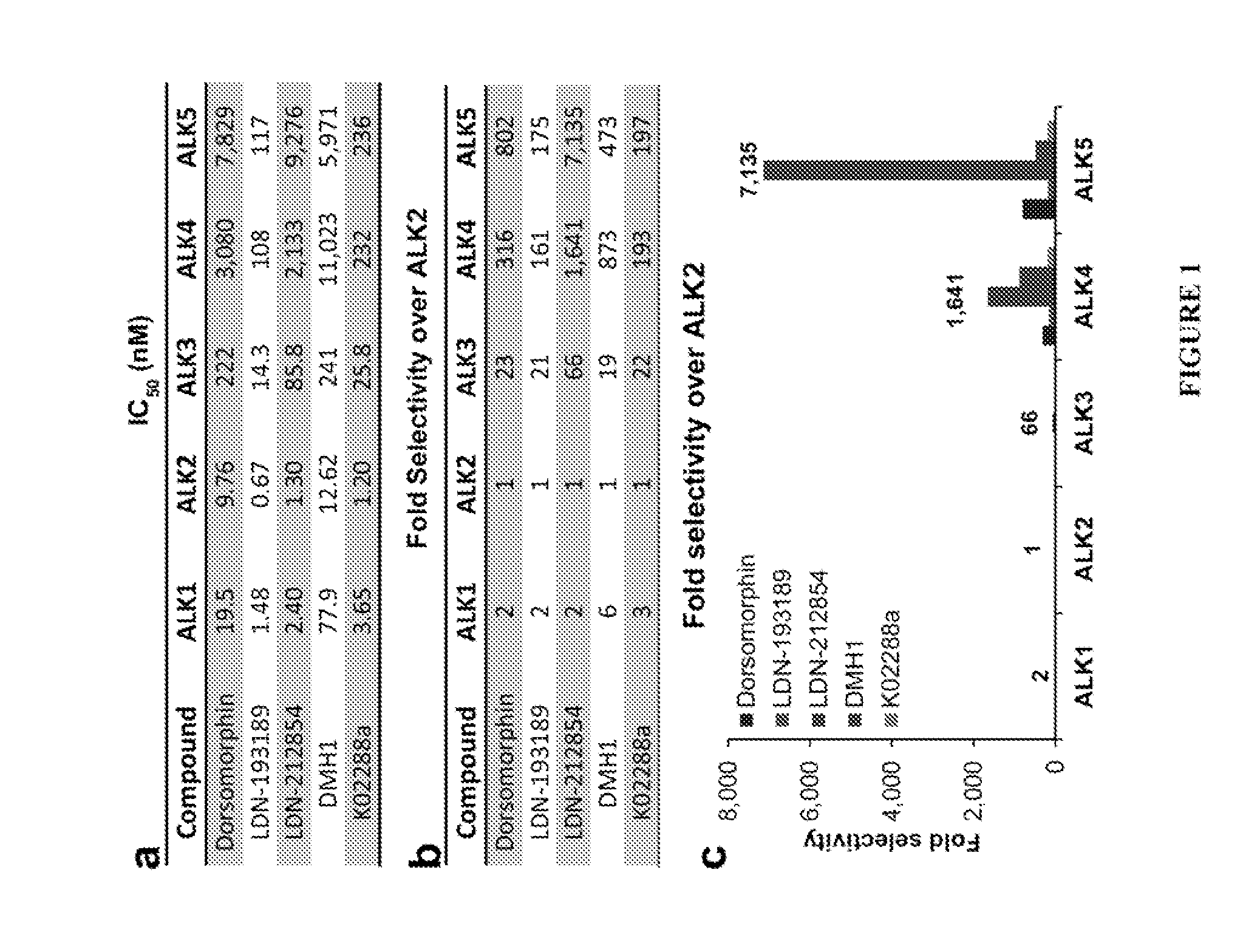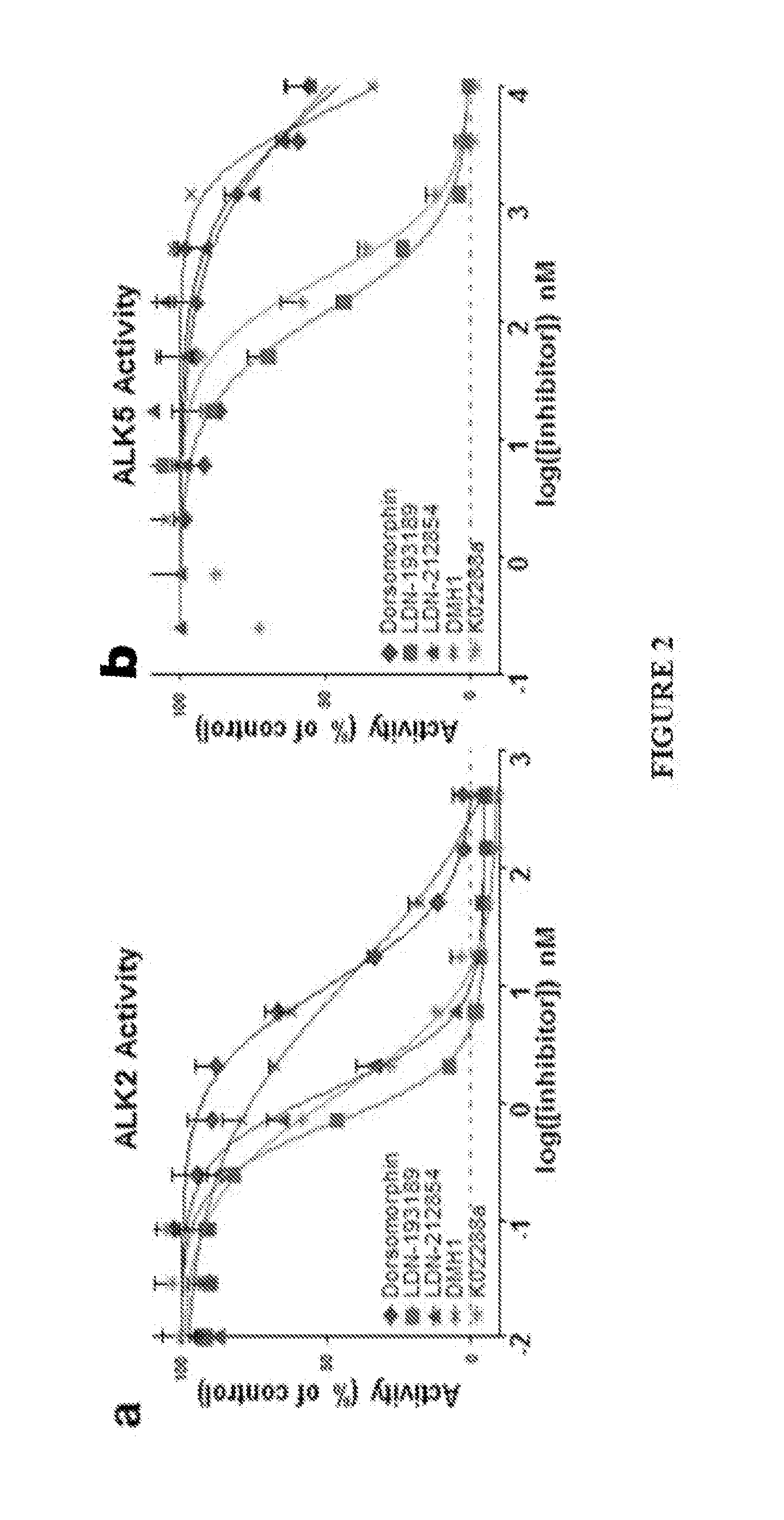Bmp inhibitors and methods of use thereof
a technology of bmp and inhibitors, which is applied in the field of bmp inhibitors, can solve the problems of limited specificity of endogenous inhibitors such as noggin and follistatin for ligand subclasses, ineffective and practical methods for inhibiting bmp signals via soluble receptors, and limited structural diversity of this signaling system, so as to reduce the circulating levels of apob-100 and/or ldl and/or total cholesterol,
- Summary
- Abstract
- Description
- Claims
- Application Information
AI Technical Summary
Benefits of technology
Problems solved by technology
Method used
Image
Examples
example 1
[0250]Equal 8 μL fractions of purified kinase (Invitrogen), ATP (Sigma), ATP [γ-32P] (Perkin Elmer), and dephosphorylated casein (Sigma) diluted in kinase buffer (Cell Signaling) containing 0.2% bovine serum albumin and supplemented with 10 mM MnCL2 to a final concentration of 2.5 nM, 6 μM, 0.05 μCi / μL, and 0.5 mg / mL respectively were added to a 96-well plate containing compounds diluted in kinase buffer at final concentrations ranging from 0.01 nM to 10 μM in triplicate. Positive controls were generated by replacing compounds with an 8 μL of just kinase buffer and negative controls were generated by replacing both the purified kinase and compounds with two 8 μL aliquots of kinase buffer. The reaction was allowed to proceed at room temperature for 45 minutes and quenched with the addition of 10 μL of 10% phosphoric acid. A multi-channel pipette was used to transfer the entire reaction volume (50 μL ) to 96-well P81 phosphocellulose filter plates (Millipore) and allowed t...
example 2
Cell Culture
[0251]C2C12 myofibroblasts cells stably transfected with BMP responsive element from the Idl promoter fused to luciferase reporter gene (BRE-Luc) and human embryonic kidney 293T cells stably transfected with the TGF-β responsive element from the PAI-1 promoter fused to luciferase reporter gene (CAGA-Luc) were cultured in DMEM (Life Technologies) supplemented with 10% FBS, L-glutamine, and pen / strep at 37° C. and 10% CO2. HepG2 human hepatoma cells (ATCC) were cultured in EMEM (Life Technologies) supplemented with 10% FBS, L-glutamine, and pen / strep at 37° C. and 10% CO2. C2C12 myofibroblasts (ATCC) were cultured in DMEM (Life Technologies) supplemented with 10% FBS, L-glutamine, and pen / strep at 37° C. and 10% CO2. Pulmonary arterial smooth muscle cells (PASMCs) were isolated from both wild type and BMPR2flox / flox mice and the latter exposed to adenovirus specifying Cre recombinase (Ad. Cre) to generate BMP type II receptor deficient (BMPR2del / del) cells, as previously d...
example 3
Luciferase Assay (BRE-Luc and CAGA-Luc)
[0252]C2C12 Bre-Luc and 293T CAGA-Luc cells were seeded at 20,000 cells in 80 μL DMEM supplemented with 2% FBS per well in tissue culture treated 96-well plates (Costar® 3610; Corning). The cells were incubated for 1 hour at 37° C. and 10% CO2 and allowed to settle and attach. The compounds of interest were diluted in DMEM at 10-fold the final concentrations ranging from 1 nM to 10 μM and added in 10 μL aliquots. Positive controls were generated by replacing the compound aliquot with just 10 μL of DMEM. The cells were then incubated for 30 min at 37° C. and 10% CO2. Finally 10 μL aliquots of adenovirus expressing constitutively active BMP and TGF-β type 1 receptors (caALK1-5) were added to achieve a multiplicity of infection (MOI) of 100. The negative controls were generated by replacing both the compound and adenovirus aliquots with just 20 μL of DMEM. Plates were left to incubate overnight for 16 to 24 hours at 37° C. and 10% CO2. After deter...
PUM
| Property | Measurement | Unit |
|---|---|---|
| pKa | aaaaa | aaaaa |
| weight | aaaaa | aaaaa |
| weight | aaaaa | aaaaa |
Abstract
Description
Claims
Application Information
 Login to View More
Login to View More - R&D
- Intellectual Property
- Life Sciences
- Materials
- Tech Scout
- Unparalleled Data Quality
- Higher Quality Content
- 60% Fewer Hallucinations
Browse by: Latest US Patents, China's latest patents, Technical Efficacy Thesaurus, Application Domain, Technology Topic, Popular Technical Reports.
© 2025 PatSnap. All rights reserved.Legal|Privacy policy|Modern Slavery Act Transparency Statement|Sitemap|About US| Contact US: help@patsnap.com



